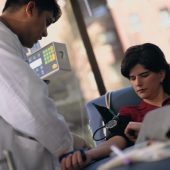- Skip Storing This Everyday Product in the Fridge Door
- Green Tea + B3 Pairing May Boost Brain Health
- Navigating Your Midlife Crisis: Embracing New Possibilities
- City Raccoons Showing Signs of Domestication
- Mapping the Exposome: Science Broadens Focus to Environmental Disease Triggers
- One Week Less on Social Media Linked to Better Mental Health
- Your Brain Changes in Stages as You Age, Study Finds
- Some Suicide Victims Show No Typical Warning Signs, Study Finds
- ByHeart Formula Faces Lawsuits After Babies Sickened With Botulism
- Switch to Vegan Diet Could Cut Your Greenhouse Gas Emissions in Half
More Americans Getting High Blood Pressure Under Control: CDC


Efforts to help millions of Americans battling high blood pressure may be succeeding, but much more work needs to be done, U.S. health officials report.
According to the U.S. Centers for Disease Control and Prevention, about two-thirds (64 percent) of people with high blood pressure had the problem “under control” during 2012, the latest year for which figures are available. The agency defined “controlled” blood pressure as readings at or below 140 mm Hg/90 mm Hg.
But that still falls short of the 70 percent goal that the U.S. Department of Health and Human Services “Million Hearts” campaign set for 2017.
“An estimated 46,000 deaths could be avoided annually if 70 percent of patients with high blood pressure were treated according to published guidelines,” wrote a team led by Milesh Patel of the CDC’s National Center for Chronic Disease Prevention and Health Promotion.
Achieving or surpassing that goal would also prevent 1 million heart attacks and strokes by 2017, the CDC said.
The report is based on 2012 data from the nationwide Healthcare Effectiveness Data and Information Set, which covers more than 113 million Americans enrolled in a range of health care plans.
The CDC report found there were “modest” improvements in how many Americans got their high blood pressure — also known as hypertension — under control, compared to 2010. However, rates varied widely by region, with the southeastern “Stroke Belt” states lagging behind.
For example, while more than 68 percent of people reporting to the HHS’ San Francisco data center had their blood pressure under control, that number dropped to just 59.5 percent for people reporting to the Atlanta or Dallas centers, the CDC said.
One expert believes that doctors play a key role in reducing the burden of high blood pressure.
“Hypertension is a key risk factor for cardiovascular disease and as a medical community it is imperative that we aggressively screen and treat those patients with high blood pressure,” said Dr. Suzanne Steinbaum, preventive cardiologist at Lenox Hill Hospital in New York City.
“Not only do we need to implement awareness campaigns for the patients, but hold the physicians to clinical standards of treatment,” she said. “It is crucial that these goals are met in order for us to save lives, and prevent Americans from suffering from heart disease and strokes.”
Overall, the CDC believes that the “70 percent blood pressure control among hypertensive patients by 2017 is achievable, but further work is needed to effectively identify, monitor and treat patients with hypertension.”
The report will be published in the Feb. 14 issue of the CDC publication Morbidity and Mortality Weekly Report.
More information
There’s more on treating high blood pressure at the American Heart Association.
Source: HealthDay
Copyright © 2025 HealthDay. All rights reserved.










